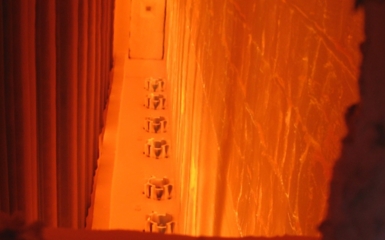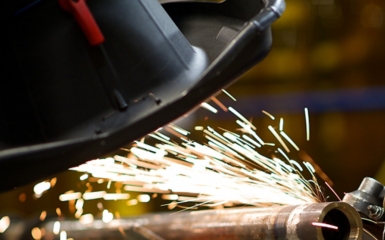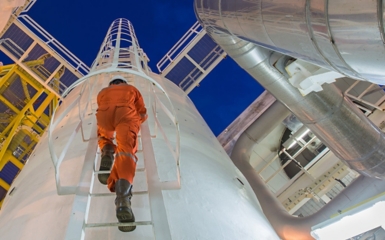Pilots are the heart of a flare. Without healthy pilots, a flare can easily become a vent. When a failure occurs in pilot fuel piping, it can significantly affect pilot performance and consequently flare performance. No one expects when installing a flare for the pilot fuel piping to fail, but it does happen. Insufficient tightening of threaded connections, flanges without double nuts or another mechanism to prevent loosening, flame impingement from adjacent flares, flame impingement from a damaged flare, improper piping support, and corrosion are all potential causes of pilot fuel piping failing. This paper will discuss steps that can be taken to mitigate the issue if it arises and preventative measures to lessen the probability of it occurring. The following assumptions are made:
- A flame front generator (FFG) is available and functional.
- The vent gas can’t be routed to another flare.
- The damaged flare will not be shut down for repair.
(Warning: Operation without pilots can result in the venting of waste gas and its consequences and may violate local regulations.)
Fuel Supply Failure Scenarios
Scenario 1. The fuel piping cracked, but the pilot fuel pressure can still be maintained. (Flame is present on the pilot tips.)
Not all failures are equal. A crack in the piping that leaks gas is not as severe as a complete break in the pipe. Depending on the size of the crack, it may still be possible to maintain fuel pressure. Maintaining fuel pressure with a cracked pipe may require more fuel flow, but the pilots can continue to operate normally. The concern in this scenario is what happens to the gas exiting through the crack. If the gas is venting and unlit, there is a minor environmental consequence but no detriment to the flare tip and its components. It is expected that over time fuel gas venting from a crack will eventually ignite. With an ignited leak, the location and direction of the resulting flame become important. For example, if the flame generated by the leak impinges on the flare tip or other components such as electrical ignition components, thermocouple junctions, brackets, pilot, molecular seal, etc., some damage should be expected. If the flame or products of combustion are being sucked into the venturi of a pilot, it can result in a pilot outage.
Close monitoring of the pilots and equipment in the vicinity of the leak is recommended. The possibility exists for the leakage rate to suddenly increase at any time which can compromise pilot operation. The facility may decide whether some of the mitigations discussed in scenario 2 should be implemented to reduce the probability of a flameout. The mechanism that caused the crack in the first place is likely still present meaning the crack is only expected to get worse over time. If an uncontrolled flame impinges carbon steel components, the potential exists for structural failure or loss of containment for the component.
Scenario 2. The fuel piping failed, and the pilot fuel pressure can’t be maintained. (Pilot pressure below minimum required to maintain flame on pilot tips.)
Loss of pilot fuel pressure means loss of pilots. There is high potential for flame out of the main flame. The following steps can be immediately taken by the facility to reduce the probability of loss of the main flame.
- Increase fuel gas flow to the flare. Having a strong main flame is the best defense against loss of the main flame when pilots are unavailable. The flow rate should be sufficient to produce an easily visible flame at the flare tip discharge.
- Fuel gas can be sent through one or more Flame Front Generator (FFG) lines to a pilot or pilots. This gas can be ignited by the main flame but may not ignite if the pilot is upwind. Advanced flare pilots typically include a mixer assembly that produces a stable, premixed flame. Flames produced from the FFG piping are diffusion flames which are less stable than a premixed pilot and are more likely to be extinguished by the wind. Flames produced by the FFG system often can’t be detected by pilot thermocouples since the combustion occurs outside the pilot windshield. If injecting fuel into more than one FFG line, care should be taken to avoid creating the “U” tube effect. The “U” tube effect occurs when a piping system has two discharges that are connected at a lower elevation (i.e. just downstream of the FFG ignition chamber). A low flow of lighter-than-air gas through a “U” tube will tend to flow out only one outlet while the other outlet has air flowing into the piping. This can generate a flammable fuel/air mixture that can flashback to the location where the fuel/air mixes.
- A combination of fuel and air can be sent through an FFG line. Sending a fuel/air mixture through the FFG line can result in a premixed flame that is more stable than a diffusion flame. Care should be taken to ensure the velocity of the fuel-air mixture is greater than the turbulent flame speed of the mixture. If the velocity in the FFG line is too low, the flame can flashback into the FFG line, potentially becoming a detonation. For a 1” FFG line and natural gas fuel, John Zink recommends a minimum of 50 SCFH of fuel and 475 SCFH of air which produces a line velocity in excess of 24 ft/s which is more than 15 times the maximum laminar flame speed of methane and should not flashback.
- Additional care should be taken when sending inert material (e.g. nitrogen, carbon dioxide, water vapor) to the flare. Be sure to enrich any inert material sufficiently to ensure a stable flame. If the flare is automatically maintaining a Combustion Zone Net Heating Value (NHVcz), the minimum NHVCZ set point can be increased to improve main flame stability. If the instrument used to measure the vent gas heating value has a slow response time such as a gas chromatograph, the benefit of raising the NHVcz setpoint increases
- If the flare is air-assisted or steam-assisted, care must be taken to avoid over-assisting the flare. The probability is higher for an over-assisted flare to be extinguished than a flare operating at the insipient smoke point.
- Once a stable main flame is established, shutoff the pilot gas to avoid fuel gas venting or an uncontrolled flame.
Additional steps can be taken but require time to mobilize.
- Install temporary pilot(s). Some vendors have temporary hook pilots that hook onto the top of the flare tip and can be installed on an operating flare.
- Rent a flare from John Zink and divert the vent gas to the rental. Once diverted, shutdown the damaged flare and repair.
- Install an IR flame detector such as John Zink’s PilotEye. Such a device will provide feedback to operators that a flame is present and an alarm if a flame out occurs. Other optical flare monitoring technologies exist that can provide notice of flame out and/or IR images of the flare.
Scenario 3. The pilots are out, and the main flame is out.
Loss of the main flame means the flare is venting the vent gas. Take the following steps immediately to relight the main flame.
Ensure there is a reasonable flow of rich gas flowing to the flare. (Gas that is lighter than air should be used. If the gas flowing to the flare is heavier than air, it could fall to grade and produce an explosive mixture). Use pilot ignition methods to try and ignite the main flame.
- Send fireballs through the FFG. Ideally send the fireballs through the pilots that are either downwind or sidewind from the flare tip. A fireball through an upwind pilot may not ignite the main flame (depends on wind speed and the flow rate of combustible gas to the flare). Ensure enough time is allowed for the fuel/air mixture to completely fill the FFG line before igniting.
- If the pilots are equipped with John Zink InstaFire® (high voltage) ignition, turn all InstaFire® Man/Off/Auto switches from Auto to Off then back to Auto. This resets the ignition timer causing InstaFire® to generate a high voltage spark within the windshield of each pilot. If a combustible fuel/air mixture is present in same location as the spark, the main flame will likely ignite. (This action can be performed while waiting for an FFG line to fill up.)
- If a shotgun with incendiary shells or a flare pistol is available, either can be used to ignite the main flame. The larger the volume of combustible gas flowing to the flare, the higher the probability of ignition. Care should be taken to plan the location of the shooter to avoid injury if there is a hard ignition. All appropriate facility safety precautions should be taken when using incendiary devices inside an operating facility.
- In the past, the use of a flaming arrow has been used to ignite a flare. If this approach is used, care should be taken to plan the location of the shooter to avoid injury if there is a hard ignition. Also plan for the arrow’s return to earth to avoid injury or damage. All appropriate facility safety precautions should be taken when using incendiary devices inside an operating facility.
- Once a stable main flame is established, shutoff the pilot gas to avoid fuel gas venting or an uncontrolled flame.
How to Improve Reliability
The following can improve pilot reliability.
- Use experienced, competent personnel for flare installation.
- Install an individual pilot gas line for each pilot without a pilot gas manifold. Failure of the piping to a single pilot won’t affect the operation of the other pilots. Individual lines also allow isolation of a damaged line to prevent fuel gas venting or an uncontrolled flame. A ½” (12 mm) pipe is sufficient to supply gas to a single pilot, but larger sizes can be used for increased stiffness or increased piping strength.
- Make pilot gas lines out of stainless steel instead of carbon steel. For offshore or coastal locations, 316 SS is recommended. For most other locations 304 SS is recommended. If the site is aware of a corrosive environment around the flare stack that would make 316 SS or 304 SS a poor choice, use steel suitable for the site. Stainless steel doesn’t corrode as quickly as carbon steel and is stronger than carbon steel at elevated temperatures. Stainless steel also produces less internal scale than carbon steel resulting in a lower probability of pilot plugging due to internal debris.
- Use socket weld fittings as much as is practicable for the pilot fuel piping. The fewer flanges and threaded connections, the lower the probability of a leak forming.
- Ensure any connections (flanges, unions, threaded connections, etc.) are properly tightened so they don’t come loose over time due to vibration. It is recommended to double-nut any flanged connections. Improper connections/tightening is one of the most common installation errors John Zink personnel witnesses.
- Ensure the proper support of the fuel and FFG piping. Hanging long lengths of fuel pipe from the pilot has resulted in broken mixers that cause the pilot not to function.
- Ensure the pilot fuel piping can accommodate thermal expansion of either the stack, the pilot fuel pipe or both. An inflexible pipe configuration that can’t accommodate thermal expansion will stress components. In the best scenario, the piping may deform without breaking. In the worst scenario, the piping may crack/break or the pilot mixer may fail. One of the most common installation errors is an insufficient allowance for thermal expansion. This can occur when the installation contractor forces fuel gas piping together and leaves the piping in a stressed state.
- During installation, blowdown all fuel piping to remove any debris that has entered the piping. If water is used to flush the piping, care should be taken to ensure all water is removed prior to closing the system. Any remaining water could freeze and plug the pilot orifices during cold weather.
- If the site experiences freezing conditions all water should be removed from the fuel gas. For example, some very cold locations bubbles pilot fuel gas through liquid methanol. This removes the water from the pilot fuel gas and prevents freezing at the pilot orifice.
- Install a properly sized Y-strainer just before the pilot orifice (John Zink standard). This strainer is a last line of defense against blockage of the orifice by debris.
- Install parallel regulators and strainers with manual block valves at grade that allow maintenance of those devices without interrupting fuel flow to the pilots. The strainers should be upstream of the regulators to protect the regulator orifice.
- Do not install automated block valves in pilot fuel gas piping. Electrical failure, compressed air failure, or logic failure could shut off fuel to the flare pilots during a critical time in the facility.
- Have an alternative fuel source if the main fuel gas supply is unreliable. Propane has been used as a backup and/or startup fuel for many facilities. A John Zink pilot designed to operate with natural gas can operate with propane at a lower fuel pressure. This makes control of the backup fuel simple, only requiring additional regulators with a lower setpoint.
- It is best practice for operators to routinely train on the operation of the FFG if one is installed. Flare pilots are highly reliable and years can go by without the need to ignite the pilots using the FFG. An operator unfamiliar with FFG operation is more likely to make errors when operating the FFG in manual mode during a stressful situation.
- Install one or more retractable pilots. A retractable pilot allows repair/replacement of the pilot, thermocouples, fuel supply hose, and wiring all while a flare is in service.
- Condensable components in the fuel gas can cause the pilot orifice to plug or the fuel flowrate to the pilot to fluctuate. Design the pilot gas piping to avoid low points so any condensate-free drains to an engineered condensate collection volume.
- Heat tracing of the pilot gas line may be necessary to avoid a large percentage of fuel condensing which can happen if a heavy fuel such as propane is used in a cold environment.
- Pilot mixers can become plugged with ice (hoarfrost) when the ambient temperature is near freezing and the atmosphere is humid. Proximity to a cooling tower steam plume can also create conditions that allow the formation of hoarfrost. If hoarfrost is a possibility, the pilot should be equipped with anti-hoarfrost heaters to keep the mixers ice-free.
Conclusions
Healthy pilots are critical to good flare operation. If a failure occurs, there are steps that can be taken to reduce the probability of flame out. Flare operation with compromised pilots has increased risk and requires close monitoring and control. An unplanned shutdown of a facility is expensive and could cost millions of dollars. Careful design and good installation practices can reduce the probability of pilot failure. As the old saying goes, an ounce of prevention is worth a pound of cure.



